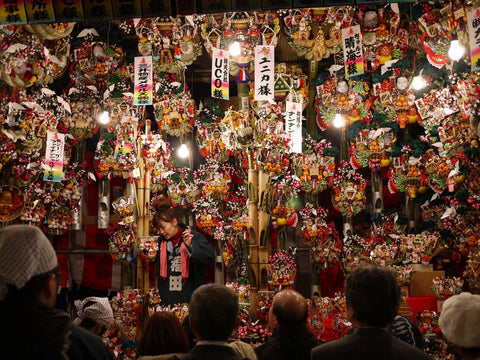Moon rabbits and autumn in Japan

Fall is the time of year known for changing leaves, cooling temperatures, and, in the west, the start of the holiday season. Folks bundle up, bake special holiday treats and tell each other autumnal folktales and spooky ghost stories. In Japan, there are many celebrations and stories that go along with the fall season as well. Read on to see how Japan celebrates the fall season.
Tsukimi

Tsukimi, or Otsukimi, is a moon-viewing festival celebrated on two different occasions every year. The full moon is usually viewed on the 15th day of the 8th month, according to the Japanese lunar calendar, and the waxing moon is viewed on the 13th day of the ninth month. These dates correlate to different days of the Gregorian calendar, depending on the year. The festival began during Japan's Heian period and ancient observers would often recite poetry while viewing the moon at its biggest and brightest.
An important part of the festival is the tale of the Old Man of the Moon and the Rabbit. According to legend, the Old Man of the Moon looked down on the earth and watched the world sleeping night after night. He became especially curious about a monkey, a fox and a rabbit that all lived together as friends. One night, the Old Man came down to earth one day disguised as a beggar to test the animal friends' kindness. He approached them as they warmed themselves around a bonfire and asked them if they would give him some food. The monkey provided the Old Man with many fruits and berries, while the fox used its cunning to catch the Old Man a fish. But the rabbit, who had nothing but himself to offer, prepared to jump into the fire so that the Old Man might eat him. Before he could do so, the Old Man took off his disguise and revealed his true self. To repay the rabbit for his generosity, he took the rabbit back with him to live on the moon.
Around Tsukimi, you'll see a lot of rabbit-themed decorations to go along with the story. There are also special foods served around this time, such as tsukimi dango, noodles topped with egg and mooncakes. Seasonal foods such as kabocha (pumpkin) and taro (a type of potato) are also served around this time. People often visit shrines (which hold parades and plays), decorate their roofs with pampas grass, and go chestnut picking. Tsukimi is a fun and busy celebration in Japan.
Autumn Leaves Viewing

Much like the cherry blossom viewing celebrations in the spring, a popular autumn activity in Japan is viewing the changing colors of the leaves. Japan is famous for its four seasons and you can find some of the most radiant autumn views in the world here.
Places like Furano, Ibaraki, Lake Kawaguchi and Kiyomizudera Temple are all popular spots to view the vibrant colors of the leaves.
Jidai Matsuri

Jidai Matsuri is a festival that dates back all the way to 1895. The "Festival of Ages" was created to celebrate the founding of Kyoto, the ancient capital of Japan before it was moved to Tokyo. The festival takes place on October 22 and features a two-hour long parade of people dressed in historical costume, particularly from the Heian period (794-1185 AD). The parade starts at the Imperial Palace and culminates at the Heian Shrine. Both the shrine and the Jidai Matsuri were created in the same year as a way to celebrate the culture and significance of Kyoto.
Culture Day

November 3 is Japan's day to celebrate Japanese achievements in the arts, sciences and culture. Parades and art exhibitions are a large part of the day's celebration, as are visits to museums and science centers. Students and professionals also debut new projects and discoveries on November 3 as well.
One of the most important events of Culture Day is the presentation of the Order of Culture award by the Imperial Family of Japan. This prestigious award ceremony is attended by many members of the academic and professional community and each year one member or group is inducted into the Order of Culture for their contributions to the fields of science, arts or culture.
The day is also celebrated throughout Japan by individual cities and regions which hold parades and festivals celebrating their unique historical cultures and contributions to Japan.
Tori No Ichi

Tori No Ichi takes place in November on days associated with the rooster in the Chinese zodiac. On these auspicious days, vendors sell ornately decorated bamboo rakes to be displayed during New Year's celebrations a few months later. Tori No Ichi is sometimes called the Rooster Rake Festival in English. Vendors not only sell rakes but also festival foods as well, and the event has a fun, festive atmosphere. Rake vendors and purchasers will engage in spirited negotiations over the price of rakes, and when an agreement is reached, they will clap their hands in a traditional rhythm called tejime to celebrate the closing of the sale.
The rakes are thought to be symbols of good luck, and are covered in almost every Japanese symbol of fortune imaginable, including maneki neko and, of course, Otafuku masks.
How do you celebrate the fall season? Let us know in the comments below!
